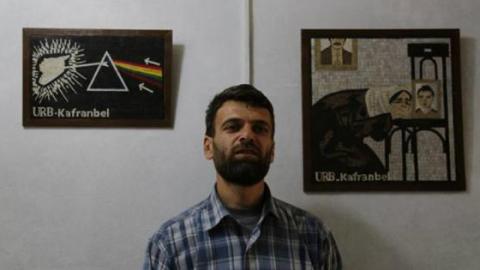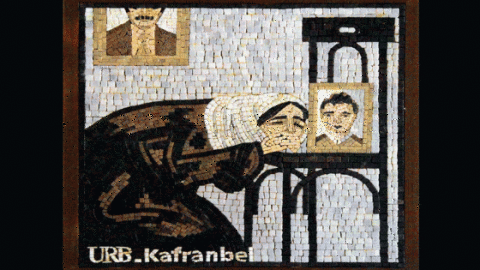Kafranbel, the town that earned its status as the Conscience of the Revolution through its world-famous banners, has taken it upon itself to preserve the memory of the Syrian uprising. In a powerful combination of past and present, it has turned to one of the oldest Syrian artcrafts: mosaics.
The first exhibition of Panorama of the Syrian Revolution was held in Kafranbel in commemoration of the third anniversary of the Syrian uprising, but the organizers are already planning to take the mosaics to exhibitions throughout the world.
The art of mosaic, based on making mural paintings through small square pieces of stone, is an enrooted artistic tradition in the Levant region. Heavily present in Syria, the “Damascene mosaic” has a strong presence in houses and furniture throughout the country. However, this craft, like many other traditions, has suffered a decline over the past decades, with the increasing shift to a more Western-influenced globalized lifestyle. Despite this, a group of activists decided to revisit the craft in the context of the community and the uprising.

“Our main goal was to provide jobs. Most people have been focusing on humanitarian aid for the past three years, and they need other types of occupations,” Mouaz Kalido, one of the organizers of the initiative, said to SyriaUntold. “We went to the Union of Revolutionary Offices and made a proposal to promote local economy by creating jobs in the field of mosaic artcraft, starting with a workshop to train specialists in this industry.”
The Union remains the only source of funding for the project so far, as activists are keen on maintaining their independence.
Most of the mosaics are representations of Kafranbel’s renowned revolutionary banners, turning paper into a more durable work of art. Others are replicas of paintings by Syrian artists, such as the breath-taking “The mother and the martyr” by Youssef Abdelke, and cartoons such as the late Palestinian artist Naji al-Ali’s. Thus, demonstrations, artistic manifestations and other historic events undergone by Syrians are set in stone, for its inhabitants and the rest of the world to remember.
The process itself is a product of the collective organizational spirit that emerged with the uprising. The mosaics provide Kafranbelis with an opportunity to work together, joining efforts in the same way they did when they prepared protests, sit-ins and other civil disobedience initiatives.
The initiative delves into the vital intersection between art and history, which has come to characterize the Syrian uprising and civic movement. As a sort of historic artistic documentary, it offers, as the name itself suggests, a "Panorama of the Syrian Revolution", a chronicle of Syrian recent history told by Syrians through their own voices, tools and traditions.




